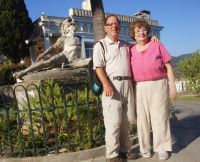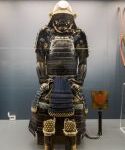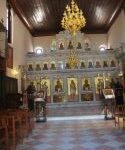Cosmopolitan Corfu
If you enter Greece from the north, by sea, you’re likely to visit the island of Corfu, Greece’s most northern island, and the 7th largest of the 1000 islands that comprise the “Greek Isles.” It’s also one of the most unusual, partly because of its “modern” history. Venetian from the fall of Constantinople in the 4th Crusade (more or less 1204 through 1797), it was successively French, Russian, and British occupied before Britain, in 1864, returned it to Greece.
 Part of that history was reflected in what we saw
Part of that history was reflected in what we saw  today. Carolyn and I chose the tour of the Achilleon, the palace built by the young and beautiful wife of Emperor Franz Joseph of Austria/Hungary. Elizabeth, better known as “Sissy,” was a member of the Bavarian Royal House, who fought depression especially after she learned Franz was having numerous affairs. She fled home, but returned on the condition that she be given a great deal of autonomy. Thus, she built a palace here in Corfu, which was devoted to her fascination with Achilles. Our guide, a Corfuite (?) with a strong British accent, enthusiastically described the statues and paintings, and regaled us with tales, long forgotten, of the Trojan War (I’ll bet most of our tour crowd had read the Iliad and the Odyssey in college; I did). The extra treat for me was that when she died (assassinated in Switzerland in 1898 by a crazed socialist), Franz Joseph sold the estate to his good friend, Kaiser Wilhelm II. The Kaiser’s contribution was to put an enormous statue of Achilles at the point where he could see it as he sailed in on his yacht, the Hohenzollern; it’s still there, but missing is his (so typical of the Kaiser) sign, “A great warrior, built by the Great Emperor of the Germans,” which lasted until Allied soldiers, recuperating in World War I when Achilleon was a hospital, took it down.
today. Carolyn and I chose the tour of the Achilleon, the palace built by the young and beautiful wife of Emperor Franz Joseph of Austria/Hungary. Elizabeth, better known as “Sissy,” was a member of the Bavarian Royal House, who fought depression especially after she learned Franz was having numerous affairs. She fled home, but returned on the condition that she be given a great deal of autonomy. Thus, she built a palace here in Corfu, which was devoted to her fascination with Achilles. Our guide, a Corfuite (?) with a strong British accent, enthusiastically described the statues and paintings, and regaled us with tales, long forgotten, of the Trojan War (I’ll bet most of our tour crowd had read the Iliad and the Odyssey in college; I did). The extra treat for me was that when she died (assassinated in Switzerland in 1898 by a crazed socialist), Franz Joseph sold the estate to his good friend, Kaiser Wilhelm II. The Kaiser’s contribution was to put an enormous statue of Achilles at the point where he could see it as he sailed in on his yacht, the Hohenzollern; it’s still there, but missing is his (so typical of the Kaiser) sign, “A great warrior, built by the Great Emperor of the Germans,” which lasted until Allied soldiers, recuperating in World War I when Achilleon was a hospital, took it down.

 I went as well to the Museum of Asian Art, tantalized by the fact that there WAS an Asian art museum on the island of Corfu. I read that it had 10000 artifacts. I wasn’t told that the building was itself worth seeing. The collection is housed in the Palace of St. George and St. Michael, which it turned out, was built by the British High Commissioner as residence and administrative center when the island was part of the Ionian islands protectorate of Great Britain (1815-1864). The palace had his throne room—if you can believe that the High Commissioner had a throne!—and the furnishings of a neoclassical building. The Asian collection was interesting as well, with the collection coming from the 19th century ambassador from Greece to Austria, who purchased the items in auctions in Vienna. The explanations were intriguing in their connection between Greece and Asia. For example, the exhibit on Buddhist sculptures dealt with Gandahar, an early period that originated in the parts of India where successors to
I went as well to the Museum of Asian Art, tantalized by the fact that there WAS an Asian art museum on the island of Corfu. I read that it had 10000 artifacts. I wasn’t told that the building was itself worth seeing. The collection is housed in the Palace of St. George and St. Michael, which it turned out, was built by the British High Commissioner as residence and administrative center when the island was part of the Ionian islands protectorate of Great Britain (1815-1864). The palace had his throne room—if you can believe that the High Commissioner had a throne!—and the furnishings of a neoclassical building. The Asian collection was interesting as well, with the collection coming from the 19th century ambassador from Greece to Austria, who purchased the items in auctions in Vienna. The explanations were intriguing in their connection between Greece and Asia. For example, the exhibit on Buddhist sculptures dealt with Gandahar, an early period that originated in the parts of India where successors to  (Greek) Alexander the Great ruled. The Buddhist statues resembled Apollo or Dionysus, with togas that could be in a Greek temple. The more I looked at the Buddhist statues, the clearer the connection became. The other link was between Chinese cloisonné and Byzantium. After the fall of Constantinople, many Byzantine artists fled to Armenia and Georgia, where their art made it on the Silk Road to China, giving rise to the art form every visitor of China today recognizes.
(Greek) Alexander the Great ruled. The Buddhist statues resembled Apollo or Dionysus, with togas that could be in a Greek temple. The more I looked at the Buddhist statues, the clearer the connection became. The other link was between Chinese cloisonné and Byzantium. After the fall of Constantinople, many Byzantine artists fled to Armenia and Georgia, where their art made it on the Silk Road to China, giving rise to the art form every visitor of China today recognizes.
The Byzantine art museum, housed in an Orthodox Church, made a similar point: mostly 16th through 18th century icons, the early ones were painted  by artists who were from Crete, where many artists had fled after the Turkish conquest of Byzantium. Later icons were painted by Cretans who had fled to Corfu after Crete fell to the Turks. The latest icons showed the influence of the Venetians, who ruled Corfu for over 400 years, and revealed additions of the Baroque period.
by artists who were from Crete, where many artists had fled after the Turkish conquest of Byzantium. Later icons were painted by Cretans who had fled to Corfu after Crete fell to the Turks. The latest icons showed the influence of the Venetians, who ruled Corfu for over 400 years, and revealed additions of the Baroque period.
The two forts , built by the Venetians, indicated the importance of Corfu as a  military and naval outpost, particularly effective in
military and naval outpost, particularly effective in  turning back the Turkish navy, then the French attacking British interests in the Mediterranean, and finally, the British protecting the Mediterranean supply lines to India. The fort has the lion of St. Marks, then the barracks of the British, and now houses the Ionian University Department of Music. For good measure, there is a small museum with relics from a Byzantine church that was on the site.
turning back the Turkish navy, then the French attacking British interests in the Mediterranean, and finally, the British protecting the Mediterranean supply lines to India. The fort has the lion of St. Marks, then the barracks of the British, and now houses the Ionian University Department of Music. For good measure, there is a small museum with relics from a Byzantine church that was on the site.
No wonder this is a major stop for cruise ships, and for tourists who want warm (now hot!) summers.